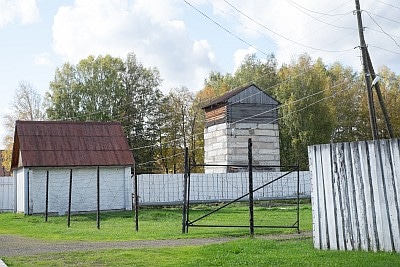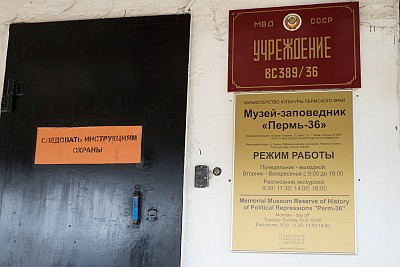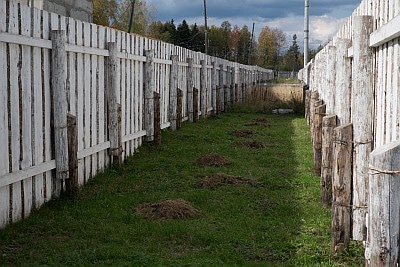Labour Camps (Gulags) in Russia
Labour Camps (Gulags) were a cruel reality during the Repression years in the USSR. A visit to Russia really is incomplete without spending at least a little time learning about the Gulags and the system of repression.
Perm 36, the Gulag Museum and the Sakharov Centre (the latter two in Moscow and easily accessible by metro) complement one another. A visit to at least one of these places may depress you, but will provide an important insight into Russian history.
The Last Surviving Labour Camp
Perm 36 was a dark place. From 1946 to 1987 inmates of this Soviet Labour Camp lived and worked under horrific conditions. Also referred to as a gulag (an acronym in Russian for “Chief Administration of Corrective Labour Camps”), Perm 36 is the only surviving forced labour camp in Russia.


While I have read about Russian labour camps, a visit to Perm 36 seemed to be another way to understand more the repression years in Soviet Russia, and when the opportunity arose to visit the camp, I welcomed it, not without some trepidation.
Conditions in the Gulag
Now maintained as a memorial site the “Museum for the History of Political Repression Perm-36” opened to the public in 1995. Here visitors can see for themselves the extreme conditions in which prisoners (both criminals and political – identified as ‘enemies of the state’) lived.
Many died from cold and disease due to their inadequate diet, harsh work and bleak living quarters. Meagre rations were allocated according to the amount of work a person did. The less work you did, the less food you received
The Entrance to Perm 36
A heavy blue steel door marks the entrance to Perm 36. On the day we visit, the museum is closed, but we are allowed entry with the tour guide who is accompanying our group through Russia. She provides a brief overview as we walk through the site.


Our visit to Perm 36 is also a personal journey. Last year in Iran, we visited the graves of my husband’s Polish grandparents. They trekked to Tehran after being freed from a Soviet Labour Camp similar to Perm 36. Like Perm 36 their camp was a logging camp.
Seeing the conditions under which they lived is moving to say the least.
A Personal Reason to visit a Gulag
Winters were incredibly harsh. It’s surreal standing here, realising that my husband’s mother, her parents and brothers spent a harsh winter in a gulag similar to Perm 36 before being allowed to leave (with only what they could carry) when Hitler invaded Russia and Polish Prisoners were released. His mother told him that they would not have survived another winter.
After passing through the heavy blue steel door, we walk through the gatehouse into the gulag itself. Watch towers look over the area which is enclosed by rows of high barbed wire fences and walls topped with barbed wire.


Our group quietly and sombrely absorb our surroundings. A song written in Cyrillic in blue paint underneath a musical score is painted on the wooden fence ahead of us. With no-one to translate the words, we wonder what they mean.
Suddenly, a siren breaks the silence. One of our group has ventured past a wire fence tripping an unseen switch signalling an attempted escape. Quite disconcerting.
With the museum essentially closed today, only some of the timber buildings which were built by prisoners themselves are open. Nevertheless, we get a feel for the harsh conditions in the work area before walking through a ‘control point’ to the living area.
The Living Quarters
In the living quarters, a room is set up to show the sleeping arrangements. Initially people slept on wooden planks, but over time they were provided with narrow metal bunk beds with thin mattresses.
Exhibits display various aspects of life in the gulag. One shows the meagre personal belongings prisoners had. There’s a description of how prisoners had to choose their footwear for the year.
The choice they were given was between heavy warm winter boots to cope with the harsh cold or lighter summer footwear. Neither boot was suitable for round year use.

Original letters sent between family members and inmates make interesting reading (our guide assisted with translation). Letters that inmates wrote home may never have reached the intended recipient as guards often never mailed the letters.
One woman who wrote a letter to Stalin declaring her husband’s innocence was sent to Perm 36 for 10 years. Others were incarcerated for similarly small “misdemeanours”.
A Disturbing Experience
Our visit to Perm provides a disturbing insight into the Soviet Labour Camps, who was sent there, why they were sent there and what awful experiences they endured. So many people didn’t survive. I wonder how any did.
Certainly, this visit has provided me with a deeper understanding of the extreme horrors of life in a gulag and under Stalin generally.
How to Get to Perm 36
- The museum is about 10 kilometers from the town Chusovoy, which is 100 km east of Perm.
- Perm 36 is not easily accessible to the average traveller. Local taxi drivers may not even be aware that it exists, nor know how to get there.
- Our tour group (travelling from Beijing to Moscow by train) visited Perm 36 as part of an optional extra offered by the tour company. We made a detour by road from Kungur on our way to the city of Perm
- Excursions to Perm 36 from the City of Perm are the best option available to travellers.
The Gulag Museum

The Gulag Museum in Moscow, as its name indicates, focuses on the political repression and labour camps in Russia.
Entering the Gulag Museum in Moscow
Entering the museum is to enter a dark and foreboding place. A display of heavy metal doors with locks and bolts sets the prison scene with the echoing sound of footsteps in a corridor and doors closing behind you.


As in Perm 36, there is a collection of letters and memoirs and personal belongings of former Gulag prisoners. Video interviews with inmates and their families provide a personal overview of how the labour camps affected individuals and families.
Personal Experiences in the Gulag
I discover that on their release inmates were ostracised by their friends and sometimes family as well. No one wanted to be associated with them. They were either concerned that they might also be targeted, or they thought that their friend must have done something wrong to be sent to a labour camp.

People were sent to the gulag for the slightest misdemeanour. Being late for work three times meant you could be sent to the gulag for three years. And telling a joke about a communist official could send you to a labour camp for up to 25 years.
People were Executed
I stand in a room where the floor is strewn with 700 000 bullet shells representing those executed during the Stalin years. Black and white photographs of the faces of the people executed project onto the far wall one after the other.
Click, one face. Click another. Click another, on and on. Each click of the projector sounding not a little like a gunshot. I’m mesmerised and overcome by the wasted lives.
On a wall in another room, a large map indicates the places where gulags were located. My husband spends time looking for the one where his family were sent. A sad and sobering moment.
Why Visit the Gulag Museum?
A visit to the Gulag Museum in Moscow is not pleasurable, but like a visit to Auschwitz or Robben Island (where Nelson Mandela was incarcerated), it’s certainly an important place to visit.
What do you need to Know about the Gulag Museum?
Tickets
- At the time of visiting, the ticket price of 300 Roubles and another 300 Roubles (with 1000Rouble deposit) for the English Audio guide was well worth the cost.
Getting to the Gulag Museum
- The Museum is about a ten-minute walk from Dostoevskaya Metro Station
The Sakharov Centre
I discover the Sakharov Centre quite by mistake. An internet search for something unrelated revealed that I could find a piece of the Berlin wall near the museum. With an afternoon free and never having been to Berlin, I set off on the Metro to find the Berlin Wall relic, and to visit the Sakharov Centre.
A Piece of the Berlin Wall
The large rectangular piece of concrete taken from the Berlin wall and embedded in a garden bed near the Sakharov Centre, is now an artwork. There’s no plaque explaining anything about the piece, and a couple nearby look nonplussed at my interest.
A memorial to liberty, dully coloured metal butterflies flutter around an elliptical hole towards the top of the concrete block. They appear to have flown to freedom through the hole.


Sakharov Centre Mascot
Another artwork, “The Rusty Angel” by Leonid Berlin, is nearby. It is a mascot for the Sakharov Centre. I approach the closed museum door and tentatively push it. The door opens, but there’s no one around, not in the entry booth nor down an open corridor.
Hesitantly, I climb the stairs to the exhibition. Feeling a little like an intruder, I pull open and inspect the contents of drawer after drawer of original documents. Mostly in Russian, the display is relatively self-explanatory.
Original Documents
Original lists of people who were executed, their photographs and pages of personal details and charge notes fill the many, many drawers. There are letters from prisoners. I can’t believe that these historic documents are here, available to anyone to touch and feel.
Work of the Sakharov Museum
This permanent exhibition is only one part of the work of the Sakharov Centre. The centre is also a place for discussion, lectures and film viewings with the objective of promoting the:
“values of freedom, democracy, and human rights; support a robust, comprehensive, and free discussion about relevant historical issues, human rights, and humanitarian problems; and aid the creation of civil society in Russia” (taken from the Mission of the Sakharov Centre)
Like Perm 36 and the Gulag Museum, the Sakharov Centre is a moving experience. Forty MILLION people perished in the repression.
It’s Important to Visit a Gulag Museum
There are so many places of interest to visit in Russia, but if you leave the country without visiting at least one museum dedicated to the repression and to Soviet Labour Camps, you will have missed learning more about a significant part of Russian history.
For another side to life in Russia, take a look at Communal Living in St Petersburg here.
